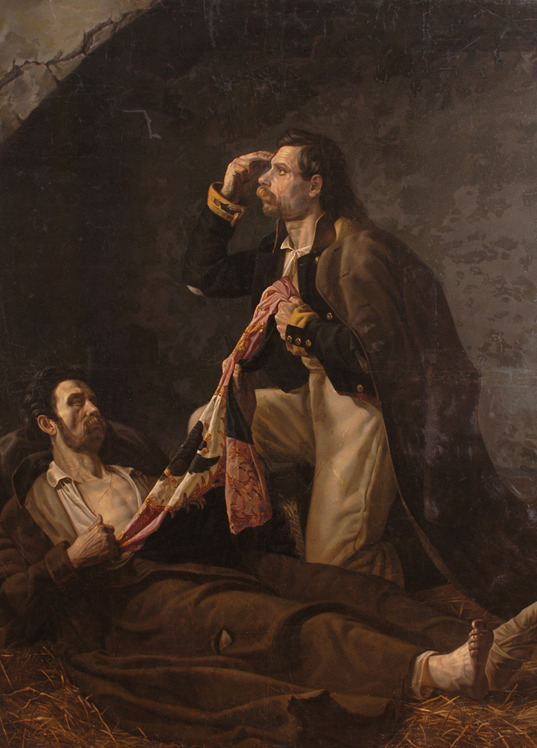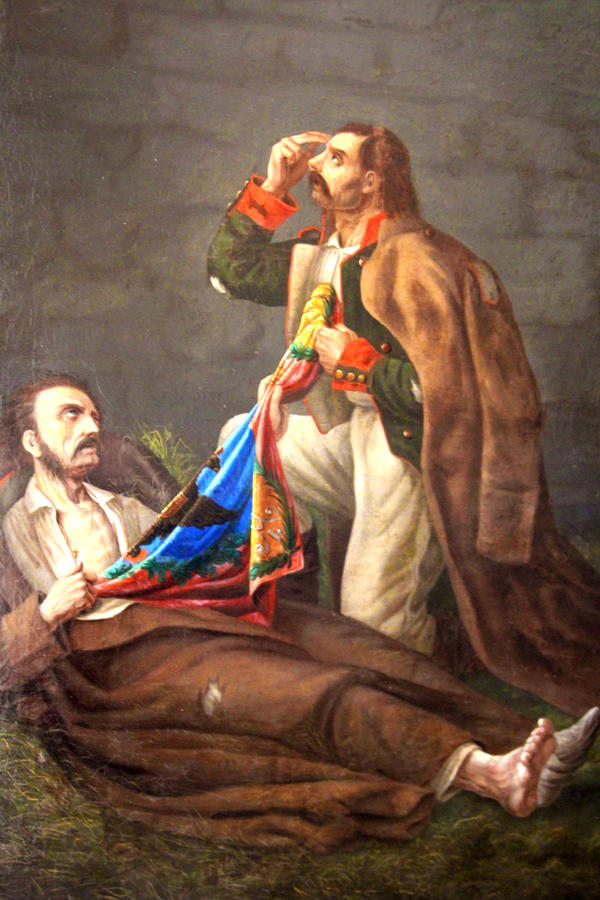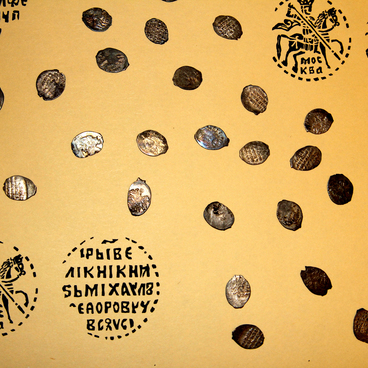The painting presented at the exposition is a copy of the famous 1846 work by Polidor Babaev The dying soldier passing the banner that he saved to his comrade. For it, Babaev was awarded a small silver and a small gold medals of the Academy of Arts.
For the painting’s narrative Babaev chose the story of a feat that Kaluga citizen Semyon Starichkov performed in 1805. “For some vices” he was conscripted into the army and for nine years he served in the Azov Musketeer Regiment. Over the years, he took part in the Italian and Swiss campaigns, rose to the rank of sub-officer, and also received the right to carry one of the “coloured” banners of the regiment.
All the banners were coloured, except for the banner of the first company – that one was white. White banners were finally abolished only in 1814.
In 1805, in the battle of Austerlitz, the regiment in which Starichkov was the standard-bearer was surrounded and defeated. The sub-officer was mortally wounded, but managed to remove the banner from the pole and hide it on his chest. In captivity, before his death, Starichkov gave the banner to the private Chaika. The latter preserved it and during the exchange of prisoners transferred the relic to the lieutenant colonel Treskin.
In the Russian army of the early 19th century, there was no tradition of rewarding heroes posthumously. But by decree of Emperor Alexander I, who was informed of Starichkov’s feat, the family of the sub-officer received money payments. All the churches of Kaluga held commemoration for the hero, thereby paying him the last honours.
Polidor Babaev (1813-1870). The dying soldier passing the banner that he saved to his comrade (feat of Semyon Starichkov)[1]
The painting, created by Babaev under the impression of this story, became very popular. Its copies in the second half of the 19th century spread throughout Kaluga, were sent to institutions of the local military department and to various regiments, including the Azov one, where Starichkov had served. Miniature lithographs from the painting hung in the hall of the petty bourgeois administration, in the barracks of the 2nd Grenadier Artillery Brigade. And the descendants of the famous sub-officer donated two such works to the museum at the Kaluga Scientific Commission.
Also in memory of Starichkov’s feat, with funds from merchants-patrons the town acquired a two-floor stone house – the first memorial monument in Kaluga. This building’s age has already reached 200 years. And, in 2006, Starichkov was officially awarded the title of ‘Honorary Citizen of Kaluga’.
For the painting’s narrative Babaev chose the story of a feat that Kaluga citizen Semyon Starichkov performed in 1805. “For some vices” he was conscripted into the army and for nine years he served in the Azov Musketeer Regiment. Over the years, he took part in the Italian and Swiss campaigns, rose to the rank of sub-officer, and also received the right to carry one of the “coloured” banners of the regiment.
All the banners were coloured, except for the banner of the first company – that one was white. White banners were finally abolished only in 1814.
In 1805, in the battle of Austerlitz, the regiment in which Starichkov was the standard-bearer was surrounded and defeated. The sub-officer was mortally wounded, but managed to remove the banner from the pole and hide it on his chest. In captivity, before his death, Starichkov gave the banner to the private Chaika. The latter preserved it and during the exchange of prisoners transferred the relic to the lieutenant colonel Treskin.
In the Russian army of the early 19th century, there was no tradition of rewarding heroes posthumously. But by decree of Emperor Alexander I, who was informed of Starichkov’s feat, the family of the sub-officer received money payments. All the churches of Kaluga held commemoration for the hero, thereby paying him the last honours.
Polidor Babaev (1813-1870). The dying soldier passing the banner that he saved to his comrade (feat of Semyon Starichkov)[1]
The painting, created by Babaev under the impression of this story, became very popular. Its copies in the second half of the 19th century spread throughout Kaluga, were sent to institutions of the local military department and to various regiments, including the Azov one, where Starichkov had served. Miniature lithographs from the painting hung in the hall of the petty bourgeois administration, in the barracks of the 2nd Grenadier Artillery Brigade. And the descendants of the famous sub-officer donated two such works to the museum at the Kaluga Scientific Commission.
Also in memory of Starichkov’s feat, with funds from merchants-patrons the town acquired a two-floor stone house – the first memorial monument in Kaluga. This building’s age has already reached 200 years. And, in 2006, Starichkov was officially awarded the title of ‘Honorary Citizen of Kaluga’.




